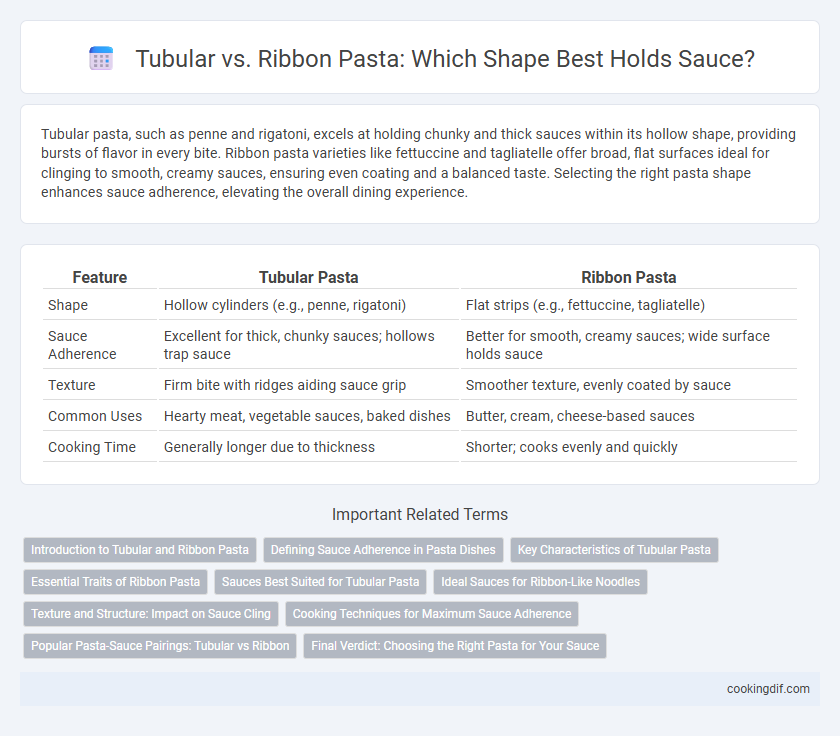Tubular pasta, such as penne and rigatoni, excels at holding chunky and thick sauces within its hollow shape, providing bursts of flavor in every bite. Ribbon pasta varieties like fettuccine and tagliatelle offer broad, flat surfaces ideal for clinging to smooth, creamy sauces, ensuring even coating and a balanced taste. Selecting the right pasta shape enhances sauce adherence, elevating the overall dining experience.
Table of Comparison
| Feature | Tubular Pasta | Ribbon Pasta |
|---|---|---|
| Shape | Hollow cylinders (e.g., penne, rigatoni) | Flat strips (e.g., fettuccine, tagliatelle) |
| Sauce Adherence | Excellent for thick, chunky sauces; hollows trap sauce | Better for smooth, creamy sauces; wide surface holds sauce |
| Texture | Firm bite with ridges aiding sauce grip | Smoother texture, evenly coated by sauce |
| Common Uses | Hearty meat, vegetable sauces, baked dishes | Butter, cream, cheese-based sauces |
| Cooking Time | Generally longer due to thickness | Shorter; cooks evenly and quickly |
Introduction to Tubular and Ribbon Pasta
Tubular pasta, such as penne and rigatoni, features hollow, cylindrical shapes that trap chunky sauces and ingredients, enhancing flavor delivery in every bite. Ribbon pasta varieties like fettuccine and linguine, being flat and broad, excel at clinging to smooth, cream-based or oil-based sauces through their wide surface area. The structural differences between tubular and ribbon pasta directly influence their sauce adherence, making each type ideal for specific culinary applications.
Defining Sauce Adherence in Pasta Dishes
Sauce adherence in pasta dishes refers to the ability of pasta shapes to hold and cling to sauces, enhancing flavor distribution and overall taste experience. Tubular pasta, such as penne or rigatoni, offers excellent sauce retention with its hollow cavities that trap thicker, chunkier sauces. Ribbon pasta, like fettuccine or tagliatelle, provides a broad surface area that excels at holding smooth, creamy sauces through increased contact and absorption.
Key Characteristics of Tubular Pasta
Tubular pasta, characterized by its hollow, cylindrical shape, excels in sauce adherence by trapping thicker and chunkier sauces inside its tubes, ensuring each bite is flavorful. Its structural design creates pockets that hold sauces like Bolognese or Alfredo more effectively compared to ribbon pasta, which primarily clings to its flat surface. The rigidity and shape of tubular pasta varieties such as penne, rigatoni, and ziti optimize the retention of hearty, meat-based, or vegetable-rich sauces.
Essential Traits of Ribbon Pasta
Ribbon pasta, characterized by its flat, broad shape such as fettuccine or pappardelle, excels at capturing and holding thicker, cream-based sauces. Its wide surface area increases sauce adherence through enhanced contact, making it ideal for rich, chunky ingredients like mushrooms or meat ragu. Unlike tubular pasta, ribbon pasta lacks internal cavities but compensates with textured edges and surface pores that trap sauces effectively, ensuring a flavorful bite every time.
Sauces Best Suited for Tubular Pasta
Tubular pasta shapes like penne, rigatoni, and ziti excel at capturing chunky, thick sauces such as meat ragu, vegetable bolognese, and creamy alfredo due to their hollow structure and ridges. These shapes allow sauce to fill the inner tube and cling to the outer surface, enhancing flavor distribution in every bite. Tubular pasta is especially effective with hearty sauces containing pieces of vegetables, meat, or cheese, providing an ideal texture contrast and sauce retention compared to flat ribbon pasta like fettuccine or linguine.
Ideal Sauces for Ribbon-Like Noodles
Ribbon-like noodles such as fettuccine, tagliatelle, and pappardelle excel at holding creamy and oil-based sauces like Alfredo, carbonara, and beurre blanc due to their flat, wide surface area. These pasta types provide ample texture for thicker sauces to cling evenly, enhancing flavor distribution in each bite. In contrast, tubular pasta works better with chunky or hearty sauces as the sauce fills the hollow center, but ribbons create a perfect balance for smooth and velvety sauces.
Texture and Structure: Impact on Sauce Cling
Tubular pasta varieties like penne and rigatoni feature ridged surfaces and hollow centers that effectively trap and hold chunky or thick sauces, enhancing sauce adherence through increased surface area. Ribbon pasta, such as fettuccine and tagliatelle, offers wide, flat surfaces that provide a smooth texture ideal for creamy, lighter sauces, ensuring even coverage without overwhelming the pasta. The structural differences between tubular and ribbon pasta directly influence texture and sauce cling, determining the best pairing for different sauce consistencies.
Cooking Techniques for Maximum Sauce Adherence
Tubular pasta, such as penne or rigatoni, excels at capturing chunky and thick sauces within its hollow centers, enhancing flavor absorption through increased surface contact. Ribbon pasta like fettuccine or linguine, with its broad and flat shape, offers an ideal canvas for lighter, creamy sauces that cling evenly across its surface. Cooking techniques like proper al dente boiling, immediate sauce tossing, and finishing pasta directly in the pan allow both tubular and ribbon pasta to maximize sauce adherence by preserving starch release and heat integration.
Popular Pasta-Sauce Pairings: Tubular vs Ribbon
Tubular pasta types like penne and rigatoni feature hollow centers that trap chunky and thick sauces, making them ideal for meat-based or vegetable sauces such as ragu or primavera. Ribbon pasta, including fettuccine and tagliatelle, offers broad, flat surfaces that hold creamy and smooth sauces like Alfredo or Bolognese effectively. Popular pairings leverage these textures to enhance sauce adherence, ensuring a balanced bite with every forkful.
Final Verdict: Choosing the Right Pasta for Your Sauce
Tubular pasta like penne and rigatoni offers superior sauce adherence due to their hollow centers and ridged surfaces, capturing chunky and thick sauces effectively. Ribbon pasta such as fettuccine and tagliatelle works best with creamy or oil-based sauces that cling to their broad, flat shapes, ensuring even coating and balanced flavor distribution. Selecting the right pasta involves matching the sauce texture and consistency to the pasta's shape for optimal taste and mouthfeel.
Tubular pasta vs ribbon pasta for sauce adherence Infographic

 cookingdif.com
cookingdif.com